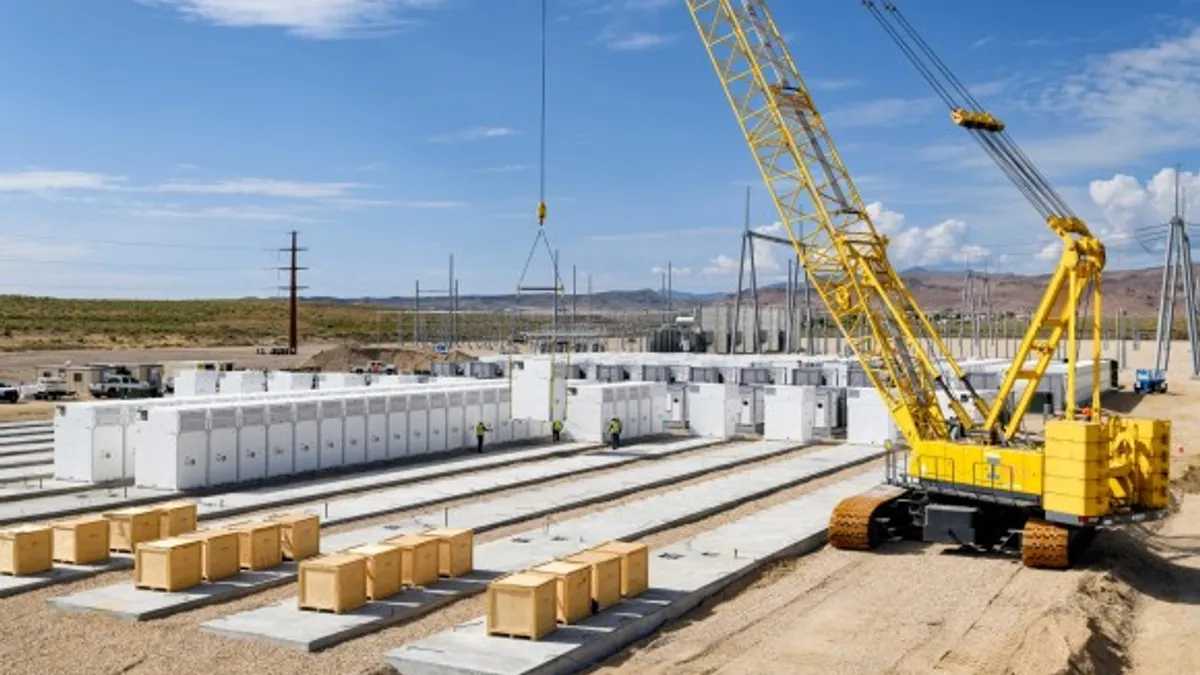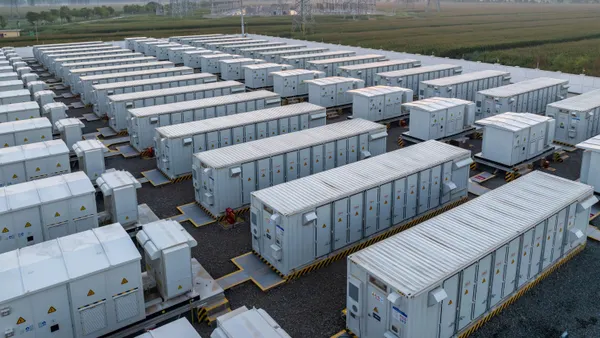In the United States, 29 states, three territories and Washington, D.C. have adopted Renewable Portfolio Standards and many experts agree that storage deployments are going to be critical to integrating the influx of renewables on to the grid. But going into 2020, the industry appears to be less bullish about the prospects of grid-scale battery storage over the next decade.
In Utility Dive's 2020 State of the Electric Utility survey, 27% of participants said they expect their organization will significantly increase grid-scale battery storage in the next 10 years — a significant reduction from 37% in 2018, and 34% in 2019. This is despite analysis by the U.S. Energy Information Administration, which forecast a spike in utility-scale battery storage beginning in 2021.
“I think that from 2015 up until 2018, 2019, there was just a lot of rapid movement in this market and from chemistry to chemistry, in some cases, large promises were made. In some cases, they were met and in others, it was observed that they were not reliable, or there were issues involved, or the return on investment was not what was suggested,” Matthew Raiford, manager of the Consortium for Battery Innovation, a research organization focused on lead batteries, told Utility Dive.
There’s also the looming issue of safety — the last couple of years have witnessed some high-profile safety-related issues with battery storage, including an explosion at an Arizona Public Service facility last April and multiple storage-related fires in South Korea. But at the same time, there are promising markets for energy storage across the world, whether in areas where energy is expensive or where electricity is highly heterogenized and isolated.
“I would venture to guess that over the next few years, there will be a refocusing in the market, looking at things like safety, reliability and the kind of technical economics of utilizing these systems,” Raiford said.
Utility-scale battery storage capacity in the U.S. quadrupled between 2014 and March 2019 — from 214 MW to 899 MW, according to the EIA. Last July, the EIA forecasted that utility-scale battery capacity could exceed 2,500 MW by 2023, if current planned facilities go up and no capacity is retired. But data from last November indicates battery storage capacity will exceed 4,525 MW by the end of 2023, Glenn McGrath, the EIA's leader of electricity statistics, uranium statistics and product innovation team, told Utility Dive.
Several factors could contribute to this predicted growth — state policies that bolster storage capacity, the Federal Energy Regulatory Commission’s Order 841, issued in 2018, which helps utility-scale battery systems participate in wholesale markets, and the competitiveness of battery systems coupled with renewables as compared to other types of generation, according to the EIA.
But storage additions aren’t “exactly blowing the doors off in an industry that has almost 1,100 GW of capacity,” McGrath said. Battery storage is “a very, very small part of the entire energy mix. That said, that small part is going to increase in size very quickly,” like wind and solar have in the last few years, he said.
“Generally speaking, over the last decade, when there have been studies done as to battery storage — particularly as it relates to things like grid resiliency and the use of renewables — that typically has been weighted toward lithium-ion,” Curt Hebert, former chairman of FERC and currently a partner at Brunini Attorneys at Law, told Utility Dive.
But lithium-ion batteries have seen some pushback over the last few years, he added, due in part to safety concerns, as well as cost effectiveness and recyclability. They are not living up to their life expectancy as advertised “and now, we are learning that there are not only safety issues but there are also issues as to what do we do at the end of this battery life?” he said, adding that both corporate boards and regulators are paying attention to these questions.
Challenges ahead: safety issues and revenue streams
Safety concerns around lithium-ion are definitely a concern for the industry, McGrath said, but these are likely problems that can be solved. Fire suppression could make battery storage applications more costly, but he would be surprised if they were to become “prohibitively costly.”
“It may limit where you can put it in, but that doesn’t mean it’ll stop them from getting put in — it’ll just shift where they go,” he said.
"If you’re playing the long game, there’s not many people that don’t think that storage is going to be a big part of the picture in a few years."

Glenn McGrath
U.S. Energy Information Administration
Safety will also be a prime focus for regulators, according to Hebert.
“When it comes to threats and issues with safety, those are a big deal not only to corporation boards, but they are certainly a big deal to regulators. So you are going to see regulators push back until they have some assurance around the safety issues associated with lithium-ion, and rightfully so,” he said.
Another cause for uncertainty over battery storage could be related to revenue streams — there’s a lot of uncertainty over how people make money with batteries, said McGrath. General bullishness over utility-scale battery storage could also vary depending on the timeframes being considered, he said — “if you’re in this for the short term, you might not be so interested in investing in a battery. If you’re playing the long game, there’s not many people that don’t think that storage is going to be a big part of the picture in a few years.”
“The market itself right now is quite immature — it’s volatile,” which makes it understandable for some players to be less optimistic about utility-scale battery storage, the Consortium for Battery Innovation’s Raiford told Utility Dive. End-of-life concerns, safety, reliability and return on investment have “caused a rethinking of what needs to be done to implement energy storage systems in a broader way.”
“These systems are being productized and working more toward economies of scale. I think that’s where the growth comes from."

Matthew Raiford
Manager, Consortium for Battery Innovation
Lead batteries could be utilized to benefit utilities, according to Raiford. Storage systems need to be easily implemented, safe and provide tangible financial benefit — “and from the perspective of lead batteries, just inherent to the actual chemistry, these are things that can be easily offered,” he said.
While the number of survey participants predicting a “significant” increase in grid-scale battery deployment dipped, 57% predicted “moderate” growth. Could fragmented moderate deployments lead to a battery boom in the next 10 years? Maybe, according to Raiford.
“These systems are being productized and working more toward economies of scale. I think that’s where the growth comes from. In some cases, it’s not just demonstration projects anymore, and these things are being distributed on a large scale. I think as that kind of activity increases, it will be something that will be more natural in the utility grid for North America or Europe,” he said.
The biggest issue for battery storage companies going forward is likely to be dealing with regulators, as they scrutinize the costs, reliability and sustainability of applications, Hebert said.
“If they see there is an industry that is not as focused on those types of issues, they are going to move away from that industry,” he added.
For additional information from the "State of the Electric Utility" Survey, listen to Utility Dive's webinar.





















